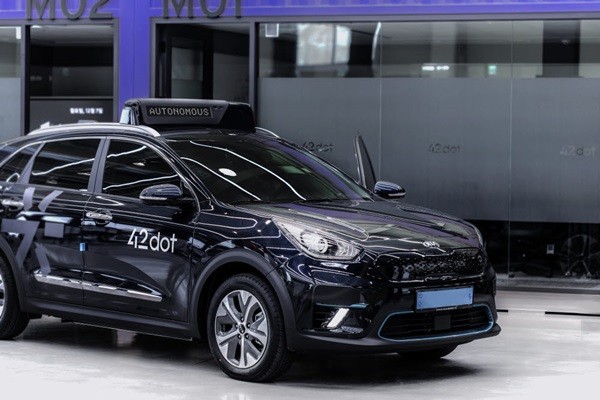A South Korean aTaaS (autonomous transportation as a service) startup called “42dot”, which received an investment from Hyundai Motor Group, is getting ready to start a level 4 autonomous driving mobility service in the middle of Seoul.
It has been able to achieve level 4 autonomy that does not require any human intervention just by combining “cameras and radars” using its own technology and not requiring any expensive LiDAR (Light Detection and Ranging) system. It is particularly drawing many eyes as it has led the development as a startup rather than how autonomous driving technologies are currently led by automakers.
42dot announced on Monday that it plans to start a demonstration service in the Sangam district. Its demonstration will involve a transportation service and actual passengers.
The company has planned a service with the Seoul Metropolitan Government and it plans to disclose details about the service sometime in the first half next year. It plans to increase number of mobility services based on its autonomous driving technology and expand its service to overseas as well.
Kia Motors’ “Niro EV” will be the vehicle that will be used during the demonstration. 42dot recently obtained an approval from the Ministry of Land, Infrastructure and Transport (MOLIT) to temporarily operate an autonomous vehicle based on Niro EV. Its level 4 autonomous driving technology is considered as a fully autonomous driving technology. While the vehicle will have a handle, the vehicle has the control over it. It is able to set up routes and drive on its own. A safety personnel will be in the vehicle all the time according to regulations.
Through this demonstration, the company plans to accumulate data and further improve its autonomous driving technology. It will expand regions of service in the future and switch to an unmanned robot taxi service. It will also increase number of its mobility services based on autonomous driving technology.

The company has developed its own hardware platform, maps, and software algorithms related to autonomous driving. Its level 4 autonomous driving technology only uses seven cameras and five radars. Its sensor fusion technology allows autonomous vehicles to recognize and figure out complicated situations. It has also received support from Hyundai Motor Group’s R&D center, which developed Niro EV, in order to improve its vehicle control technology.
“Although we will consider an option that includes LiDAR sensors, cameras, and radars if LiDAR sensor prices go down in the future, we are not there yet.” said a representative for 42dot. “In order to develop a technology that is both effective and can be applied immediately, we have only used cameras and radars to develop a level 4 autonomous driving technology.”
The company also does not use a HD map that is seen as a necessary element for autonomous driving. It uses instead a less complicated map that is developed by its own technology and is still able to find locations accurately. It also developed its own camera-based data collecting system to update its map. This system is able to cut maintenance cost by 90% compared to when a HD map is used.
The autonomous vehicle will also utilize the Seoul Metropolitan Government’s next-generation C-ITS (Cooperative Intelligent Transport Systems) infrastructure. The Sangam district is a testbed for “autonomous driving converged with 5G communication”. The vehicle will operate while exchanging information with the C-ITS infrastructure utilizing mobile network. Risk of accidents is extremely low as the vehicle is able to accurately recognize locations of intersections and crosswalks and changes in signals.
In the past, 42dot proved stability of its autonomous driving technology by going through various scenarios in K-City that was built to test autonomous vehicles in real environments. A test vehicle was able to recognize cars that were making right turns and displayed driving that was natural to the traffic flow. It was also able to quickly recognize a car that was stopped in a tunnel where there is a drastic change in lighting and avoid a potential collision.
“With our own technologies, we have developed camera sensors, autonomous driving algorithms, simplified map, and hardware platform for autonomous driving.” said CEO Song Chang-hyeon of 42dot. “By securing competitive price for our sensors and hardware platform, mapping cities, and improving our algorithms, we are going to focus on bringing the commercialization of fully autonomous vehicles earlier than expectations.”
Staff Reporter Park, Jinhyung | jin@etnews.com